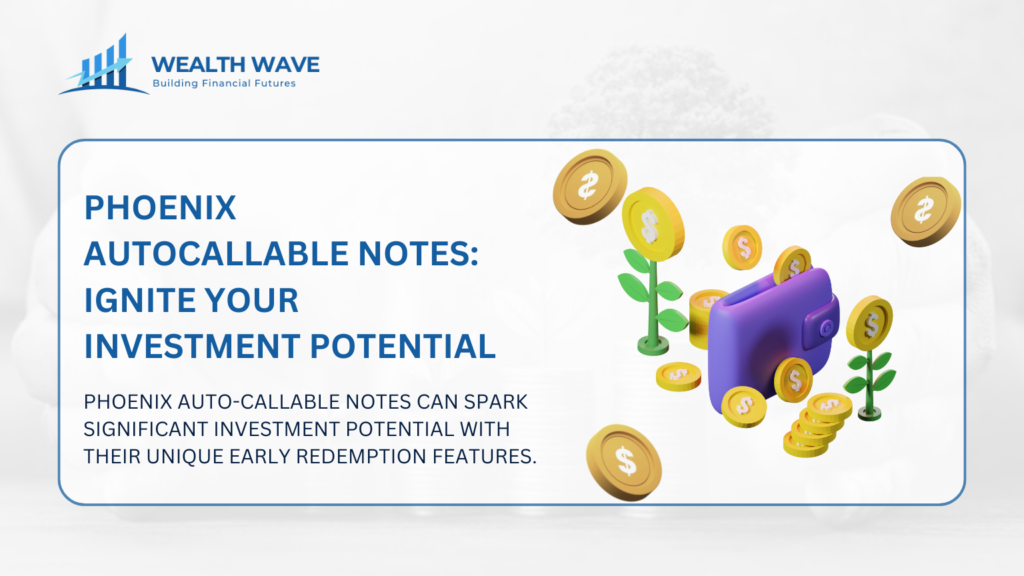
Investing can feel like wandering through a maze, especially with the array of choices laid out before us: stocks, bonds, mutual funds… it’s a lot. Trust me, I know that feeling of scratching your head in confusion all too well.
Then along came phoenix autocallable notes—a real game-changer for me. These are fancy financial concoctions cooked up by investment banks that tie your returns to how well assets like the S&P 500 Index perform.
What caught my eye was discovering that at the start—the Initial Valuation Date—these notes could be valued anywhere from $951.60 right up to their issue price.
So, what sets these phoenix autocallable notes apart? In this piece, we’re taking a deep dive into their world, exploring intriguing features like memory interest and put options that crank up the potential rewards but also dial-up risks such as credit risk and market illiquidity.
We’re on a mission to unravel these complex concepts into bite-sized insights because clarity is priceless when you’re navigating the investment landscape. Ready to demystify the murky waters together?
Key Takeaways
- Phoenix Autocallable Notes are structured products by investment banks that link returns to the performance of underlying assets, like the S&P 500 Index. They tend not to pay regular coupons and might redeem automatically based on asset performance.
- These notes come with risks including credit risk since they’re unsecured debt securities, limited liquidity making them hard to sell quickly, and inaccurate pricing due to their complex valuation methods.
- Special features such as Memory Interest and Put Options can offer added benefits. The Memory Feature allows recovery of missed interest payments if conditions improve later. The Put Option lets investors sell the note back at a set price before maturity.
- There are costs associated with investing in Phoenix Autocallable Notes, including issue price discrepancies and fees from issuing banks. Furthermore, they do not provide regular dividend income as traditional bonds do.
- Alternatives for investors include traditional bonds offering fixed payments or equity-linked notes that connect returns directly to stock performances without complex structures like those found in autocallable variants.
Understanding Structured Notes

Structured notes provide investors with unique ways to gain exposure to various assets. They combine traditional securities with derivatives, creating investment opportunities that are distinct and appealing.
Definition

Phoenix Autocallable Notes are structured products offered by investment banks. These notes fall under the category of debt securities. They provide us with the potential for enhanced returns linked to the performance of underlying assets or indices.
Typically, the value of these notes derives from other assets, such as the S&P 500 Index.
With an estimated value on the Initial Valuation Date set between $951.60 and the issue price, these notes have a tenor of approximately one year. Phoenix Autocallable Notes do not pay a regular coupon, distinguishing them from standard auto-callable notes.
Investors can benefit from the unique payoff structure that these structured notes offer.
Characteristics

Phoenix Autocallable Notes possess distinctive characteristics that appeal to investors. These notes are structured products offered by investment banks, providing potentially enhanced returns linked to the performance of an underlying asset, such as the S&P 500 Index.
They feature a tenor of approximately one year, which means they have a relatively short investment horizon.
Investors should note that these notes do not offer regular coupon payments, unlike traditional auto-callable notes. The value of Phoenix Autocallable Notes on the Initial Valuation Date is expected to fall between $951.60 and the issue price.
Their unique attributes, such as the Memory Interest feature, allow for accumulated returns over time, adding complexity to their payoff structure while managing risks associated with credit and lack of liquidity.
Advantages
Phoenix Autocallable Notes offer notable advantages for investors. They link returns to the performance of an underlying asset or index, such as the S&P 500 Index. This structure enhances our potential for increased returns.
We benefit from the possibility of automatic redemption based on the Reference Level of each Basket Constituent. If the market performs well, these notes can redeem automatically through Autocall Redemption.
These notes provide principal protection to a certain extent, allowing us to feel secure in our investment. The UBS AG Phoenix Autocallable Notes with Memory Interest enhance our earning potential without regular coupon payments.
Their estimated value on the Initial Valuation Date ranges between $951.60 and the issue price. With a tenor of approximately 1 year, they represent a flexible option in the investment landscape.
Disadvantages
Phoenix Autocallable Notes carry notable disadvantages. One major concern is credit risk. These notes are unsecured debt securities. If the issuing bank faces financial challenges, we may not recover our investments.
Lack of liquidity poses another challenge. We might find it difficult to sell these notes quickly in the market.
Pricing can also be misleading. The value on the Initial Valuation Date is estimated between $951.60 and the issue price. This gap can lead to inaccurate pricing. We must consider these risks before investing in structured products like Phoenix Autocallable Notes.
Exploring Phoenix Autocallable Notes

Exploring Phoenix Autocallable Notes reveals their unique payoff structure and intriguing risk features, making them a compelling option for investors. We encourage you to discover more about these innovative financial instruments.
Payoff Structure
The payoff structure of Phoenix Autocallable Notes hinges on the performance of an underlying portfolio, such as the S&P 500 Index. These structured products offer a unique feature: they can automatically redeem if certain performance levels are met on specific call observation dates.
Our potential for enhanced returns increases when the Reference Level of each Basket Constituent exceeds a predetermined barrier.
If the conditions for redemption are not met, the notes may provide no regular coupon payment, distinguishing them from other autocallable securities. The estimated value of these notes on the Initial Valuation Date ranges from $951.60 to the issue price.
With a tenor of approximately one year, we must consider the intrinsic risks tied to the structured nature of these financial instruments while evaluating their payoff structure.
Risk Analysis
Phoenix Autocallable Notes carry several risks that we must consider. Credit risk stands out, as these notes represent unsecured debt securities. In this case, UBS AG issues the Phoenix Autocallable Notes.
If UBS AG encounters financial difficulty, investors might face losses. Liquidity also poses a challenge. Phoenix Autocallable Notes may not trade often, making it harder for us to sell them promptly.
We also face the risk of inaccurate pricing. Structured products can have complex valuations. Furthermore, we should consider other risks, including market volatility and the performance of underlying assets like the S&P 500 Index.
These factors can impact payoff structures. Understanding these risks is crucial when evaluating our investment in Phoenix Autocallable Notes.
Special Features: Memory and Put Feature
The features of Memory and Put make Phoenix Autocallable Notes unique. The Memory Feature allows us to recover missed interest payments if the notes are called later. This feature can enhance our returns, especially in a fluctuating market.
With this provision, we may receive the total interest due, even if it was not paid earlier.
The Put Feature offers investors a choice. This option allows us to sell the note back to the issuer at a predetermined price before maturity. We gain the ability to limit losses in a declining market.
These special features make Phoenix Autocallable Notes an interesting choice for investors seeking optimized securities.
Key Elements of Phoenix Structured Notes

Phoenix structured notes incorporate unique features that enhance their appeal to investors. They offer a smoothing mechanism for the autocall barrier, which can optimize returns while managing risk effectively.
Smoothing the Autocall Barrier
Smoothing the autocall barrier plays a crucial role in the functionality of Phoenix Autocallable Notes. These structured products utilize a unique approach to enhance investor returns.
We find that the notes link their performance to an underlying asset, such as the S&P 500 Index. This connection allows us to benefit from favorable market conditions.
The structure of these notes features specific autocall observation dates. If the reference level of each basket constituent meets or exceeds the barrier on any observation date, the notes redeem automatically through Autocall Redemption.
This mechanism helps us achieve better outcomes in varying market situations. By integrating memory features, these notes provide us additional potential for recovery in case of initial underperformance, thus smoothing the autocall barrier effectively.
Multi-Asset: Worst-Of Approach
We utilize the Multi-Asset: Worst-Of Approach in Phoenix Autocallable Notes to enhance potential returns. This strategy links the performance of multiple assets, such as stocks or indices.
The payoff structure ensures we receive the worst-performing asset’s return among the chosen assets. This method helps us manage risks while aiming for higher redemption prices.
By leveraging the Worst-Of Approach, we can better navigate market fluctuations. If one asset performs poorly, our payout depends on its performance. Even though Phoenix Autocallable Notes do not pay regular coupons, this strategy allows for potential compensation, especially with the estimated value between $951.60 and the issue price on the Initial Valuation Date.
Other Variants: Autocall Twin-Win and Autocall with One Star Feature
Shifting our focus from the Worst-Of approach, we find that two notable variants of Phoenix Autocallable Notes are the Autocall Twin-Win and the Autocall with One Star Feature. The Autocall Twin-Win offers investors unique opportunities for returns.
This variant automatically redeems if one of the underlying assets performs well at certain observation dates.
The Autocall with One Star Feature, on the other hand, adds more flexibility. It allows for early redemption if the reference asset reaches a specific level. Both variants show how structured notes can adapt to various investment strategies.
They enhance our experience within the investment banking sector and promote effective risk management.
Risks Associated with Phoenix Structured Notes

Phoenix structured notes carry various risks that investors must understand. Credit risk poses a concern if the issuer faces financial difficulties, while liquidity may become limited in certain market conditions.
Credit Risk
Credit risk poses a significant concern for investors in Phoenix Autocallable Notes. These notes are unsecured debt securities. They are heavily reliant on the financial stability of the issuer, such as UBS AG.
If the issuer experiences financial trouble, we face the risk of losing our investment.
The absence of regular coupons adds another layer of risk. Investors must rely solely on the performance of the underlying asset, like the S&P 500 Index. If the index underperforms, the notes may not yield expected returns.
Understanding these risks is vital when investing in structured products like Phoenix Autocallable Notes.
Lack of Liquidity
Lack of liquidity presents a significant challenge for Phoenix Autocallable Notes. These structured products often have limited markets for trading, making it difficult for us to sell them quickly without losing value.
Investors may find it hard to exit their positions, especially if they need cash or want to avoid losses.
Phoenix Autocallable Notes, like most fixed-income securities, do not pay regular coupons. This feature can further restrict liquidity as investors seek consistent income. We must consider this risk when evaluating our investment strategies.
Inaccurate Pricing
Inaccurate pricing poses significant risks for Phoenix Autocallable Notes. These structured products derive their value from underlying assets, like the S&P 500 Index. Mispricing can lead to unexpected losses for investors.
The complexity of option pricing contributes to these inaccuracies.
The estimated value of these notes is between $951.60 and the issue price on the Initial Valuation Date. Investors must recognize that they will not receive a regular coupon, unlike many callable bonds.
Understanding these nuances helps us navigate the market more effectively. Next, we will delve deeper into the terms of Phoenix Structured Notes.
Additional Risks to Consider
We face several risks when investing in Phoenix Autocallable Notes. Credit risk stands out as a significant concern since these notes represent unsecured debt securities. The lack of liquidity can also hinder our ability to sell these investments easily.
We must be cautious about inaccurate pricing. The estimated value on the Initial Valuation Date is between $951.60 and the issue price. This could lead to unexpected losses if market conditions shift.
Furthermore, we should consider additional factors. These structured products do not pay regular coupons, which can impact cash flow. We might also encounter other risks unique to the underlying assets, such as market volatility.
Understanding these elements helps us make informed decisions about our investment in Phoenix Autocallable Notes.
Understanding the Terms of Phoenix Structured Notes

Understanding the terms of Phoenix Structured Notes requires us to examine several key components. Caps and barriers play significant roles in determining potential payouts, while costs associated with these notes can influence our investment choices.
The Role of Caps
Caps play a crucial role in Phoenix Autocallable Notes. They limit the maximum payout we can receive from these structured products. For example, if the underlying asset significantly increases in value, the cap prevents us from benefiting fully from that growth.
Typically, investment banks set these caps based on the anticipated performance of the underlying assets, such as the S&P 500 Index.
These caps help balance risk and reward. They protect issuers from extreme payouts while providing us with potential profit opportunities. We must consider these caps when evaluating Phoenix Autocallable Notes.
They influence the expected returns and overall investment strategy for these equity-linked notes.
Barrier on a Structured Note
A barrier plays a crucial role in structured notes, including Phoenix Autocallable Notes. This barrier determines the conditions under which investors will receive their returns. For instance, the Notes will automatically call if the Reference Level of each Basket Constituent hits the barrier on any Autocall Observation Date.
This mechanism links the performance of the notes to other assets, such as the S&P 500 Index.
Investors must consider the implications of the barrier carefully. If a Basket Constituent falls below the established level, it can affect the potential for enhanced returns. Investors should also note that these Phoenix Autocallable Notes do not pay a regular coupon.
Understanding the barrier’s impact is essential for making informed decisions about these investment tools.
The Absence of Dividends
The absence of dividends plays a crucial role in Phoenix Autocallable Notes. Investors should know that these notes do not provide regular coupon payments. Instead, the returns link directly to the performance of underlying assets like the S&P 500 Index.
This structure can result in enhanced returns, but it also means we need to focus on the potential gains from the asset performance rather than relying on periodic income.
We recognize that many investors prefer fixed income from dividends. Yet, in the case of Phoenix Structured Notes, the investment strategy centers on the price movement of the associated assets.
This approach can create considerable opportunities for profit, but it does involve risk due to the lack of steady payouts.
Costs Associated with Phoenix Structured Notes
Phoenix Structured Notes come with several costs that investors need to understand. We must account for any issue price above the expected value on the Initial Valuation Date. These notes estimate a value between $951.60 and the issue price.
Investors should also consider potential fees from investment banks offering these debt tools, such as UBS AG and RBC.
Moreover, the absence of regular coupon payments differentiates Phoenix Autocallable Notes from other investment types. We face additional costs if we seek liquidity for these notes.
Their nature as unsubordinated, unsecured debt securities can further impact our financial decisions. Analyzing these costs helps us make informed choices regarding our investment in equity-linked notes.
Potential Alternatives
Investors may consider several alternatives to Phoenix Autocallable Notes. One option includes traditional bonds, which offer fixed interest payments. Investors receive consistent income without complex structures.
Another alternative involves equity-linked notes. These products link returns to stock performance but usually provide a more straightforward payoff structure.
Structured products like autocallable notes may attract attention. They can offer potential benefits, but they also carry risks. Investors must evaluate their risk tolerance before committing.
We should explore various options that align with our financial goals and investment strategies.
Conclusion

Phoenix Autocallable Notes offer unique investment opportunities. We have explored their structure, risks, and potential benefits. These notes link returns to underlying assets like the S&P 500 Index.
Understanding the characteristics helps us make informed decisions. We should consider both the advantages and disadvantages before investing. How can we apply what we’ve learned to our financial strategies? Exploring additional resources can enhance our understanding further.
Taking action now can position us for greater financial success.
FAQs
Q1. What are Phoenix Autocallable notes?
Ans. Phoenix Autocallable notes are a type of equity-linked securities that investors use for optimization.
Q2. How do Phoenix Autocallable notes work?
Ans. These notes link to the performance of equities or an equity index, allowing investors to optimize their investment strategies.
Q3. Are there risks involved with Phoenix Autocallable notes?
Ans. Like all equity-linked securities, these autocallable notes carry certain market risks due to their connection with the fluctuating stock market.
Q4. Why would an investor choose Phoenix Autocallable Notes over other types of securities?
Ans. Investors might prefer them because they offer potential for higher returns and improved portfolio optimization compared to traditional securities.




